You can Download Samacheer Kalvi 10th Science Book Solutions Guide Pdf, Tamilnadu State Board help you to revise the complete Syllabus and score more marks in your examinations.
Tamilnadu Samacheer Kalvi 10th Science Solutions Chapter 16 Plant and Animal Hormones
Samacheer Kalvi 10th Science Plant and Animal Hormones Textual Evaluation Solved
I. Choose the Correct Answer.
Question 1.
Gibberellins cause _____.
(a) Shortening of genetically tall plants
(b) Elongation of dwarf plants
(c) Promotion of rooting
(d) Yellowing of young leaves.
Answer:
(c) Promotion of rooting
Question 2.
The hormone which has positive effect on apical dominance is:
(a) Cytokinin
(b) Auxin
(c) Gibberellin
(d) Ethylene
Answer:
(b) Auxin
Question 3.
Which one of the following hormones is naturally not found in plants?
(a) 2, 4 – D
(b) GA3
(c) Gibberellin
(d) IAA.
Answer:
(a) 2, 4 – D
Question 4.
Avena coleoptile test was conducted by:
(a) Darwin
(b) N. Smit
(c) Paal
(d) F.W. Went
Answer:
(d) F.W. Went
Question 5.
To increase the sugar production in sugarcanes they are sprayed with _____.
(a) Auxin
(b) Cytokinin
(c) Gibberellins
(d) Ethylene.
Answer:
(d) Ethylene.
![]()
Question 6.
LH is secreted by:
(a) Adrenal gland
(b) Thyroid gland
(c) Anterior pituitary
(d) Hypothalamus
Answer:
(c) Anterior pituitary
Question 7.
Identify the exocrine gland _____.
(a) Pituitary gland
(b) Adrenal gland
(c) Salivary gland
(d) Thyroid gland.
Answer:
(c) Salivary gland
Question 8.
Which organ acts as both exocrine gland as well as endocrine gland?
(a) Pancreas
(b) Kidney
(c) Liver
(d) Lungs
Answer:
(a) Pancreas
Question 9.
Which one is referred to as “Master Gland”?
(a) Pineal gland
(b) Pituitary gland
(c) Thyroid gland
(d) Adrenal gland.
Answer:
(b) Pituitary gland
II. Fill in the blanks.
Question 1.
______ causes cell elongation, apical dominance and prevents abscission.
Answer:
Auxin.
Question 2.
______ is a gaseous hormone involved in abscission of organs and acceleration of fruit ripening.
Answer:
Ethylene.
Question 3.
____ causes stomatal closure.
Answer:
Abscisic acid.
Question 4.
Gibberellins induce stem elongation in _____ plants.
Answer:
Corn and Pea.
Question 5.
The hormone which has a negative effect on apical dominance is _____.
Answer:
Cytokinin.
![]()
Question 6.
Calcium metabolism of the body is controlled by _____.
Answer:
Parathormone.
Question 7.
In the Islets of Langerhans, beta cells secrete _____.
Answer:
Insulin.
Question 8.
The growth and functions of the thyroid gland are controlled by _____.
Answer:
Hormone T3 and T4
Question 9.
Decreased secretion of thyroid hormones in the children leads to _____.
Answer:
Cretinism.
III. Match the following.
Question 1.
(a) Match the Column I with Columns II and III.
| Column I | Column II | Column III |
| Auxin | Gibberella fujikuroi | Abscission |
| Ethylene | Coconut milk | Intermodal elongation |
| Abscisic acid | Coleoptile tip | Apical dominance |
| Cytokinin | Chloroplast | Ripening |
| Gibberellins | Fruits | Cell division |
(b) Match the following hormones with their deficiency states.
| Hormones | Disorders |
| 1. Thyroxine | (a) Acromegaly |
| 2. Insulin | (b) Tetany |
| 3. Parathormone | (c) Simple goitre |
| 4. Growth hormone | (d) Diabetes insipidus |
| 5. ADH | (e) Diabetes mellitus |
Answer:
(a)
| Column I | Column II | Column III |
| Auxin | Coleoptile tip | Apical dominance |
| Ethylene | Fruits | Ripening |
| Abscisic acid | Chloroplast | Abscission |
| Cytokinin | Coconut milk | Cell division |
| Gibberellins | Gibberella fujikuroi | Intermodal elongation |
(b)
1. (c) Simple goitre
2. (e) Diabetes mellitus
3. (b) Tetany
4. (a) Acromegaly
5. (d) Diabetes insipidus
IV. State whether True or false, If false write the correct statement.
Question 1.
A plant hormone concerned with stimulation of cell division and promotion of nutrient mobilization is cytokinin.
Answer:
True.
Question 2.
Gibberellins cause parthenocarpy in tomato.
Answer:
True.
![]()
Question 3.
Ethylene retards senescence of leaves, flowers and fruits.
Answer:
False.
Correct Statement: Ethylene hastens the senescence of leaves, flowers and fruits.
Question 4.
Exophthalmic goitre is due to the over secretion of thyroxine.
Answer:
True.
Question 5.
The pituitary gland is divided into four lobes.
Answer:
False.
Correct Statement: The Pituitary gland is composed of two lobes and performs different functions.
Question 6.
Estrogen is secreted by corpus luteum.
Answer:
False.
Correct Statement: Estrogen is produced by the Graafian follicles of the ovary.
V. Assertion and Reasoning Questions
Direction: In each of the following questions a statement of assertion (A) is given and a corresponding statement of Reason (R) is given just below it. Mark the correct statement as,
(a) If both A and R are true and R is the correct explanation of A
(b) If both A and R are true but R is not the correct explanation of A
(c) A is true but R is false
(d) Both A and R are false.
Question 1.
Assertion: Application of cytokinin to marketed vegetables can keep them fresh for several days.
Reason: Cytokinins delay senescence of leaves and other organs by mobilisation of nutrients.
Answer:
(d) Both A and R are false.
Question 2.
Assertion (A): Pituitary gland is referred to as “Master gland”.
Reason (R): It controls the functioning of other endocrine glands.
Answer:
(a) If both A and R are true and R is the correct explanation of A.
Question 3.
Assertion (A): Diabetes mellitus increases blood sugar levels.
Reason (R): Insulin decreases blood sugar levels.
Answer:
(a) If both A and R are true and R is the correct explanation of A.
VI. Answer in a word or sentence.
Question 1.
Which hormone promotes the production of male flowers in Cucurbits?
Answer:
Gibberellins promote the production of male flowers in Cucurbits.
Question 2.
Write the name of synthetic auxin.
Answer:
2, 4 Dichloro phenoxy Acetic Acid is the synthetic hormone.
![]()
Question 3.
Which hormone induces parthenocarpy in tomatoes?
Answer:
Gibberellins are efficient in the formation of seedless fruit, inducing parthenocarpy in tomatoes.
Question 4.
What is the hormone responsible for the secretion of milk in female after child birth?
Answer:
Prolactin stimulates the secretion of milk in female after child birth.
Question 5.
Name the hormones which regulate water and mineral metabolism in man.
Answer:
Antidiuretic or vasopressin hormone regulates water and mineral metabolism in man.
Question 6.
Which hormone is secreted during emergency situation in man?
Answer:
Adrenaline and Noradrenaline is secreted during emergency situation in man.
Question 7.
Which gland secretes digestive enzymes and hormones?
Answer:
The pancreas is exocrine and endocrine in nature. The exocrine pancreas secretes pancreatic juice which plays a role in digestion. The endocrine portion (Islets of Langerhans) secrete hormones.
Question 8.
Name the endocrine glands associated with kidneys.
Answer:
Adrenal gland is associated with kidneys.
VII. Short Answer Questions.
Question 1.
What are synthetic auxins? Give examples.
Answer:
Artificially synthesized auxins, which have the properties like auxins are called as synthetic auxins, eg. 2, 4-D (2, 4-Dichlorophenoxy Acetic acid, Indole-3-Propionic Acid, alpha – Naphthalene Acetic Acid (NAA), 2, 4, 5-T (2, 4, 5-Trichlorophenoxy Acetic acid) are some of the synthetic auxins.
Question 2.
What is bolting? How can it be induced artificially?
Answer:
Rosette plant (genetic dwarfism) plant exhibit excessive intermodal growth when they are treated with gibberellins. This sudden elongation of a stem followed by flowering is called bolting.
Question 3.
Bring out any two physiological activities of abscisic acid.
Answer:
- During water stress and drought conditions, Abscisic acid causes stomatal closure.
- ABA induces bud dormancy towards the approach of winter in trees like birch.
Question 4.
What will you do to prevent leaf fall and fruit drop in plants? Support your answer with reason.
Answer:
Artificially synthesized auxin to be sprayed to prevent leaf fall and fruit drop as Auxin prevent the formation of abscission layer.
Question 5.
What are chemical messengers?
Answer:
A chemical messenger is any compound that serves to transmit a message. A chemical messenger refers to hormones.
![]()
Question 6.
Write the differences between endocrine and exocrine gland.
Answer:
The exocrine gland secretes juices, which plays a role in digestion. An endocrine portion is made up of endocrine glands, which secrete hormones. The pancreas is exocrine and endocrine in nature.
Question 7.
What is the role of parathormone?
Answer:
Parathormone regulates calcium and phosphorous metabolism in the body. They act on bone, kidney and intestine to maintain blood calcium levels.
Question 8.
What are the hormones secreted by the posterior lobe of the pituitary gland? Mention the tissues on which they exert their effect.
Answer:
- Vasopressin or Antidiuretic hormone.
- Oxytocin is the two hormones of the posterior lobe of the pituitary gland.
In kidney tubules, the vasopressin hormone increases the reabsorption of water. It reduces the loss of water through urine.
Oxytocin helps in the contraction of the smooth muscles of the uterus at the time of childbirth and ” milk ejection from the mammary gland after childbirth.
Question 9.
Why are thyroid hormones refered as personality hormone?
Answer:
Thyroid hormones are essential for normal, physical, mental and personality development. So, it is called as personality hormone.
Question 10.
Which hormone requires iodine for its formation? What will happen if the intake of iodine in our diet is low?
Answer:
The hormones secreted by the thyroid gland are:
- Triiodothyronine (T3)1
- Tetraiodothyronine or Thyroxin (T4), which need an amino acid tyrosine and Iodine for its formation.
If the intake of Iodine in our diet is low or due to the inadequate supply of iodine in our diet leads to the enlargement of the thyroid gland, which protrudes, as swelling in the neck and is called as goitre.
VIII. Long Answer Questions
Question 1.
(a) Name the gaseous plant hormone. Describe its three different actions in plants.
Answer:
Ethylene is a gaseous plant hormone.
- Ethylene promotes the ripening of fruits. Eg: Tomato, Apple, Mango, Banana, etc.
- Ethylene inhibits the elongation of stem and root in dicots.
- Ethylene hastens the senescence of leaves and flowers.
(b) Which hormone is known as a stress hormone in plants? Why?
Answer:
Abscisic acid increases the tolerance of plants to various kinds of stress. So, it is also called a stress hormone. It is found in the chloroplast of plants.
Question 2.
Describe an experiment which demonstrates that growth-stimulating hormone is produced at the tip of the coleoptile?
Answer:
Went’s experiment was done by Frits warm out. This experiment demonstrates the growth-stimulating hormone Auxin is produced at the tip of the coleoptile.
He did a series of experiments in Avena Coleoptiles. In his first experiment, he removed the tips of Avena coleoptiles. The cut tips did not grow, indicating that the tips produced something essential for growth.
In his second experiment, he placed the agar blocks on the decapitated coleoptile tips. The coleoptile tips did not show any response.
In his third experiment, he placed the detached coleoptile tips on agar blocks. After an hour, the tips were discarded and placed this agar block on the decapitated coleoptile. It grew straight up, indicating that some chemical had diffused from the cut coleoptile tips into the agar block, which stimulated the growth.
From these experiments, Went concluded that, the chemical diffusing from the tip of coleoptile was responsible for the growth and he named it as “Auxin”.
![]()
Question 3.
Write the physiological effects of gibberellins.
Answer:
- Application of gibberellins on plants stimulate extraordinary elongation of intemode. Eg: Com and Pea.
- Treatment of rosette plants with gibberellin induces sudden shoot elongation followed by flowering. This is called bolting.
- Gibberellins promote the production of male flowers in monoecious plants (Cucurbits).
- Gibberellins break dormancy of potato tubers.
- Gibberellins are efficient than. auxins in inducing the formation of seedless fruit – Parthenocarpic fruits (Development of fruits without fertilization) Eg: Tomato.
Question 4.
Where are estrogens produced? What is the role of estrogens in the human body?
Answer:
Estrogen, the female sex hormone is produced by the Graafian follicles of the ovary.
Role of estrogen:
- It brings about the changes that occur during puberty.
- It initiates the process of oogenesis.
- It stimulates the maturation of ovarian follicles in the ovary.
- It promotes the development of secondary sexual characters (breast development and high pitched voice, etc).
Question 5.
What are the conditions which occur due to lack of ADH and insulin? How are the conditions different from one another?
Answer:
ADH:
Deficiency of ADH causes a disorder called diabetes insipidus.
Deficiency of ADH reduces the reabsorption of water and causes an increase in urea output (polyuria). This deficiency disorder is called Diabetes insipidus.
IX. Higher Order Thinking Skills (HOTS) Questions
Question 1.
What would be expected to happen if,
- Gibberellin is applied to rice seedlings?
- A rotten fruit gets mixed with unripe fruits.
- When cytokinin is not added to the culture medium.
Answer:
- When gibberellins are applied, it stimulates, the extraordinary elongation of internodes.
- The mass of undifferentiated cell is called callus. If the rotten fruits get mixed with unripe fruits, then the ethylene produced from the rotten fruits will hasten the ripening of the unripe fruits.
- If cytokinin is not added to the culture medium, then the cell division, growth and differentiation will not be observed.
Question 2.
A plant hormone was first discovered in Japan when rice plants were suffering from Bakanae disease caused by Gibberella fujikoroi. Based on this information answer the following questions:
(a) Identify the hormone involved in this process.
Answer:
Gibberellin is involved in this process.
(b) Which property of this hormone causes the disease?
Answer:
It stimulates extraordinary elongation of intemode.
(c) Give two functions of this hormone.
Answer:
- Gibberellin break dormancy of potato tubers.
- Gibberellin promotes the production of male flower in monoecious plant (Cucurbits).
![]()
Question 3.
Senthil has high blood pressure, protruded eyeball and increased body temperature. Name the endocrine gland involved and hormone secretion responsible for this condition.
Answer:
The endocrine gland is Thyroid gland, and the hormones secreted are Triiodothyronine (T3) and Tetraiodothyronine or Thyroxine (T4). The excess secretion of the Thyroid hormone leads to Grave’s disease. The symptoms are protrusion of eyeballs (exophthalmia), increased metabolic rate, high body temperature, profuse sweating, loss of body weight and nervousness.
Question 4.
Sanjay is sitting in the exam hall. Before the start of the exam, he sweats a lot, with increased rate of heart beat. Why does this condition occur?
Answer:
It is due to secretion of Epinephrine and Norepinephrine as it produced during conditions of stress and emotion. They are called as “Emergency hormones” or flight, fright and fight hormone.
Question 5.
Susan’s father feels very tired and frequently urinates. After clinical diagnosis, he was advised to take an injection daily to maintain his blood glucose level. What would be the possible cause for this? Suggest preventive measures.
Answer:
The deficiency of insulin causes Diabetes mellitus. He has Diabetes mellitus. Increase in blood sugar level (Hyperglycemia). He was advised to take an injection, Insulin, which helps in the conversion of glucose into glycogen, which is stored in the liver. It decreases the concentration of glucose in the blood.
Preventive measures:
- Manage the weight
- Exercise regularly
- Eat a balanced healthy diet
- Limit alcohol intake
- Quit smoking
- Control the blood pressure
Textbook Activities Solved
Activity 1.
Place two or three unripe tomatoes in a brown paper bag with a ripe banana and roll the top closed. In another bag place two or three unripe tomatoes only and roll the top closed, Observe what happens to the tomatoes? Why?
Answer:
As the banana continues to ripen in the first bag, it produces ethylene gas. The gas trapped in the bag will cause tomatoes to ripen. The tomatoes remain unripe in the second bag.
Samacheer Kalvi 10th Science Plant and Animal Hormones Additional Questions Solved
I. Fill in the blanks.
Question 1.
The chemical substances produced by plants are called _____.
Answer:
Hormones.
Question 2.
Tie two lobes of thyroid glands are connected by means of a narrow band of tissue called _____.
Answer:
Isthmus.
Question 3.
The chief cells of parathyroid glands are _____.
Answer:
Parathormone.
Question 4.
The other name for adrenal gland is _____.
Answer:
Supra Renal.
Question 5.
The hormones secreted by the adrenal cortex are _____.
Answer:
Corticosteroids
Question 6.
During water stress and drought conditions _______ causes stomatal closure.
Answer:
Abscisic acid.
Question 7.
Glucagon helps the break down of ______ to glucose in the liver.
Answer:
Glycogen.
![]()
Question 8.
The adrenal medulla is composed of ______ cells.
Answer:
Chromaffin.
Question 9.
The male sex hormone _______ is responsible for the development of secondary sexual characters.
Answer:
Testosterone.
Question 10.
_______ is a gaseous plant hormone, mainly concerned with maturation and ripening of fruits.
Answer:
Ethylene.
Question 11.
The other name for pituitary gland is _____.
Answer:
Hypophysis.
Question 12.
The glandular follicles of the thyroid gland are filled with colloid material called _____.
Answer:
Thyroglobulin.
II. Match the following.
Question 1.
| 1. Morphogenesis | (a) Chromaffin cells |
| 2. Bakanae disease | (b) Male sex hormone |
| 3. Tetany | (c) Thymus |
| 4. Testosterone | (d) Gibberella fujikuroi |
| 5. Adrenal medulla | (e) Female sex hormone |
| 6. Thymosin | (f) Callus in tissue culture |
| 7. Estrogen | (g) Muscle spasm |
Answer:
- (f) Callus in tissue culture
- (d) Gibberella fujikuroi
- (g) Muscle spasm
- (b) Male sex hormone
- (a) Chromaffin cells
- (c) Thymus
- (e) Female sex hormone.
III. Choose the odd one out.
Question 1.
Auxins, Parthenocarpy, apical dominance, Parathormone?
Answer:
Parathormone.
Question 2.
Senescence, Dormancy, Estrogen, abscission?
Answer:
Estrogen.
Question 3.
Glucagon, Endocrine, Exocrine, Gibberellins?
Answer:
Gibberellins.
Question 4.
Norepinephrine, Isthmus, tyrosine, thyroglobulin?
Answer:
Norepinephrine.
Question 5.
Gonads, Thyroid, Cytokinin, Thymus?
Answer:
Cytokinin.
IV. Match the following endocrine glands with their location.
Question 1.
| 1. Pituitary gland | (a) Female sex gland |
| 2. Thyroid gland | (b) Male sex gland |
| 3. Parathyroid | (c) Above the kidney |
| 4. Islets of Langerhans | (d) The posterior surface of the thyroid lobe |
| 5. Adrenal gland | (e) The upper part of the chest, the lower end of the trachea |
| 6. Testes | (f) Base of midbrain |
| 7. Ovary | (g) Pancreas |
| 8. Thymus | (h) Trachea |
Answer:
- (f) Base of midbrain
- (h) Trachea
- (d) The posterior surface of the thyroid lobe
- (g) Pancreas
- (c) Above the kidney
- (b) Male sex gland
- (a) Female sex gland
- (e) The upper part of the chest, the lower end of Trachea.
V. Write ‘True’ or ‘False’ for the following statements. Write the correct statement for false:
Question 1.
Auxins, cytokinins and gibberellins inhibit plant growth, while abscisic acid and Ethylene promote plant growth.
Answer:
False.
Correct Statement: Auxins, cytokinins and gibberellins promote plant growth, while abscisic acid and ethylene inhibit plant growth.
![]()
Question 2.
Glucagon helps in the breakdown of glycogen to glucose in the liver.
Answer:
True.
Question 3.
The thymus is partly an endocrine gland and partly a lymphoid gland.
Answer:
True.
Question 4.
Leydig cells from the cells of a female. Gonads located in the pelvic cavity.
Answer:
False.
Correct Statement: Leydig cells from the endocrine part of the testes.
Question 5.
Cretinism is caused due to increased secretion of the thyroid hormones in children.
Answer:
False.
Correct Statement: Cretinism is caused due to decreased secretion of the thyroid hormones in children.
Question 6.
Cytokinin promotes the growth of lateral buds even in the presence of apical buds.
Answer:
True.
VI. Answer the following in a word or with a sentence.
Question 1.
Where are Auxins produced?
Answer:
Auxins are produced at the tip of stems and roots from where they migrate to the zone of elongation.
Question 2.
What is Richmond Lang effect?
Answer:
Delaying the process of ageing in plants with the application of cytokinin is called Richmond Lang effect.
Question 3.
What is Richmond Lang effect?
Answer:
Application of cytokinin delays the process of ageing in plants. This is called Richmond Lang effect.
Question 4.
Give the uses of progesterone.
Answer:
Progesterone maintains pregnancy and regulates the menstrual cycle.
Question 5.
What are the secretions of alpha and beta cells of Islets of Langerhans?
Answer:
Alpha cells secrete glucagon and beta cells secrete Insulin.
Question 6.
What is the main function of Glucogen.
Answer:
Glucogon converts excess amount of glycogen stored under the muscle and liver to glucose. Thus raising the blood glucose level.
![]()
Question 7.
Name the two types of sex glands.
Answer:
Testes and Ovaries.
Question 8.
Specify the symptoms of acromegaly.
Answer:
Acromegaly leads to abnormal enlargement of head, face, hand and feet.
Question 9.
Name the three layers of the adrenal cortex.
Answer:
- Zona glomerulosa
- Zona fasciculata
- Zona reticularis
Question 10.
What is Endocrinology?
Answer:
The branch of biology which deals with the study of the endocrine glands is called Endocrinology.
VII. Answer the following briefly.
Question 1.
Name the types of plant hormones.
Answer:
- Auxins
- Cytokinins
- Gibberellins
- Abscisic acid
- Ethylene.
Question 2.
Growth hormone is important for normal growth. Explain.
Answer:
Growth hormone promotes the development and enlargement of all tissues •of the body. It stimulates the growth of muscles, cartilage and long bones. It controls cell metabolism.
Question 3.
What are Ductless glands? Why are they called so?
Answer:
Endocrine glands are called ductless glands because their secretions are diffused into the bloodstream, and are carried to the different parts of the body. They do not have specific ducts to carry the hormones.
Question 4.
Why pancreas is called as dual gland?
Answer:
The exocrine part of the pancreas produces pancreatic juice. The endocrine part produce islets of Langerhans, consists of two cells namely alpha cells that produce a hormone called glucagon and Beta cells that produce insulin. So, it is called as dual gland.
Question 5.
Write any three physiological effects of cytokinins.
Answer:
- Cytokinins induce cell division.
- Cytokinins promote the growth of lateral buds even in the presence of apical buds.
- Cytokinesis causes cell enlargement.
Question 6
Which gland is a link between endocrine and lymphoid gland.
Answer:
Thymus is partly an endocrine gland and partly a lymphoid gland. It is located in the upper part of the chest covering the lower end of trachea. Thymosin is the hormone secreted by the thymus.
![]()
Question 7.
What are the functions of thyroid hormones? Write any three points.
Answer:
- Production of energy by maintaining the Basal Metabolic Rate (BMR) of the body.
- Helps to maintain normal body temperature.
- Influences the activity of the Central Nervous System.
Question 8.
What are plant hormones?
Answer:
Plant hormones are organic molecules that are produced at extremely low concentration in plants. These molecules control morphological, physiological and biochemical responses.
Question 9.
Explain any three functions of Testosterone.
Answer:
- It influences the process of spermatogenesis.
- It stimulates protein synthesis and controls muscular growth.
- Responsible for the development of secondary sexual characters (distribution of hair on body and face and deep voice pattern, etc.).
Question 10.
Write a short note on the thymus gland.
Answer:
The thymus gland is partly an endocrine gland and partly a lymphoid gland. It is located in the upper part of the chest covering the lower end of the trachea. Thymosin is the hormone secreted by Thymus.
Functions:
- It has a stimulatory effect on the immune function.
- It stimulates the production and differentiation of lymphocytes.
VIII. Draw a labelled diagram for the following.
Question 1.
Hormonal interaction in plant growth and development.
Answer:
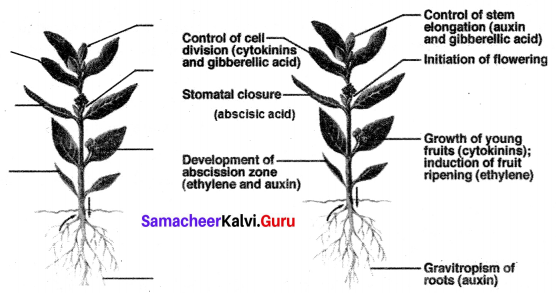
Question 2.
Pancreas
Answer:
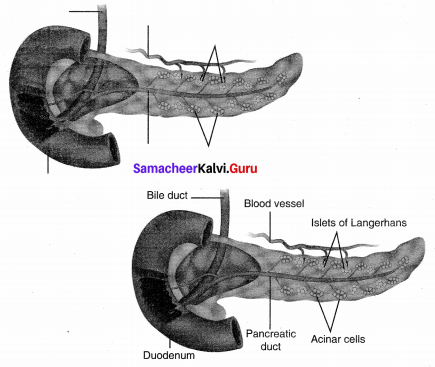
Question 3.
Adrenal gland
Answer:
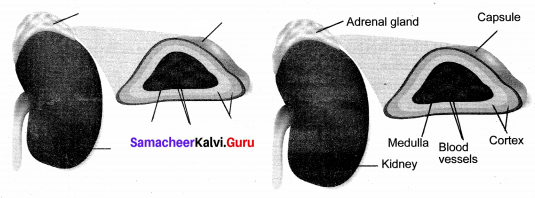
IX. Answer the following in detail.
Question 1.
With a neat labelled diagram, explain the pituitary gland and the types of hormones.
Answer:
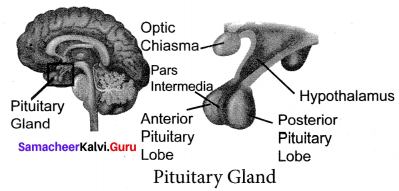
The pituitary gland is a pea-shaped compact mass of cells located at the base of the midbrain. As it regulates and controls the other endocrine glands, it is called “Master gland”
1. Hormones secreted by anterior pituitary:
(a) Growth Hormone (GH): It promotes the development and enlargement of all tissues. It stimulates the growth of muscles, cartilage and long bones. It controls cell metabolism. Decreased secretion of growth hormone leads to Dwarfism in children characterised by stunted growth, delayed skeletal formation and mental disability. Oversecretion of growth hormone leads to gigantism in children. Characterised by abnormal enlargement of head, face, hands and feet.
(b) Thyroid Stimulating Hormone (TSH) – a growth of thyroid gland.
(c) Adrenocorticotrophic hormone (ACTH) – Protein synthesis in the adrenal cortex.
(d) Gonadotrophic hormones (GTH) – for the normal development of Gonads.
The other two hormones are Follicle Stimulating Hormone (FSH); Luteinizing Hormones (LH)
(e) Prolactin (PRL) Initiates the development of mammary glands during pregnancy and production of milk after childbirth.
2. Hormones secreted by the posterior lobe:
(a) Vasopressin or Antidiuretic hormone (ADH) – It reduces the loss of water through urine. Deficiency of ADH reduces the reabsorption of water and causes an increase in urine output (polyuria). This deficiency disorder is called Diabetes insipidus.
(b) Oxytocin – It helps in the contraction of the smooth muscles of the uterus at the time of childbirth and milk ejection from the mammary gland after childbirth.
Question 2.
With a neat labelled diagram, explain thyroid gland, functions of thyroid hormones and the thyroid dysfunction.
Answer:
The thyroid gland is composed of two distinct lobes lying one on either side of the trachea. The two lobes are connected by means of a narrow band of tissue called as the isthmus, the gland is composed of glandular follicles and lined by cuboidal epithelium. The follicles are filled with colloid material called thyroglobulin. An amino acid tyrosine and iodine are involved in the formation of thyroid hormone.
The hormones secreted by the thyroid gland are:
- Triiodothyronine (T3)
- Tetraiodothyronine or Thyroxine (T4)
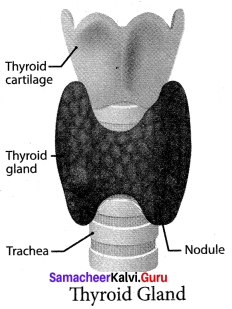
Functions of Thyroid hormone:
- Production of energy by maintaining the Basal Metabolic Rate (BMR) of the body.
- Helps to maintain normal body temperature.
- Influences the activity of the Central Nervous System.
- Controls growth of the body and bone formation.
- Essential for normal physical, mental and personality development. So it is called personality hormone.
- Regulates cell metabolism.
When the thyroid gland fails to secrete the normal level of hormone, the condition is called thyroid dysfunction. It leads to the following conditions:
1. Hypothyroidism: It is caused due to the decreased secretion of the thyroid hormones.
- Goitre: Goitre is caused due to the inadequate supply of iodine in our diet. It leads to the enlargement of the thyroid gland, protruded, marked swelling in the neck and is called goitre.
- Cretinism: It is caused due to decreased secretion of thyroid hormone in children. The conditions are stunted growth, mental defect, lack of skeletal development and deformed bones. They are called as cretins.
- Myxoedema: It is caused by the deficiency of thyroid hormone in adults. They are mentally sluggish, increase in body weight, puffiness of the face, hand etc.
2. Hyperthyroidism: It is caused due to the excess secretion of the thyroid hormone, which leads to Grave’s disease. The symptoms are protrusion of the eyeballs (Exopthalmia), increased metabolic rate, high body temperature, sweating, loss of body weight and nervousness.